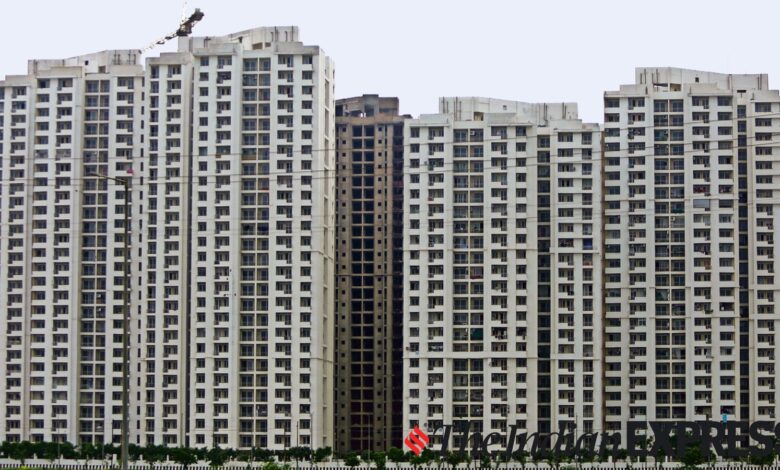Is living above the 16th floor ‘hazardous’ to health?

Air pollution and increasing AQI levels have adversely impacted the quality of life in many north Indian states, including Delhi NCR. But is it worse for people living in high-rise buildings? Here’s what health coach Dr Mickey Mehta says.
“At higher altitudes in a high-rise, oxygen levels are slightly lower than the ground level. The air quality in urban cities, at higher levels, is full of pollutants, which stagnate and linger around in the air. Life has debilitating effects when away from the earth’s magnetic field. The organs age faster because of instability and disorientation. Blood pressure, heart, even your breath, could all be affected by this silent threat (sic),” Dr Mehta said on Instagram.
Is it so? Let’s find out.
Dr Sanggita Checker, consultant chest physician, Wockhardt Hospitals agreed with Dr Mehta and shared living on higher floors can be quite a better experience and provides a spectacular view but over time it can increase the risk of various respiratory issues due to “indoor air quality”. “This can lead to respiratory problems like rhinitis, asthma, or chronic respiratory conditions.,” said Dr Checker.
 Pollution affects all (Express Photo by Prem Nath Pandey)
Pollution affects all (Express Photo by Prem Nath Pandey)
Air pressure decreases as you go higher in elevation, including in high-rise buildings. “However, the change is generally minimal within the height range of most residential buildings”, emphasised Dr Ravi Shekhar Jha, pulmonologist, director pulmonology, MD, MRCP, Fortis Hospital, Faridabad.
While oxygen levels do decline at higher altitudes, the drop in oxygen concentration is unlikely to be clinically significant in healthy adults in high-rise buildings, pointed out consultant neurologist Dr Sudhir Kumar, Apollo Hospitals, Hyderabad. “However, in vulnerable groups, such as those with known heart or lung diseases, or the elderly population, it can cause minor symptoms,” Dr Kumar added.

Dr Vikas Mittal, director, pulmonologist, CK Birla Hospital®, Delhi too said that living in high-rise buildings does not inherently pose risks to lung health. “In fact, residing at higher altitudes within urban areas often reduces exposure to common ground-level pollutants such as vehicular emissions, dust, and industrial smoke. Proper ventilation systems in high-rises further enhance indoor air quality by circulating fresh air and filtering out particulate matter,” said Dr Mittal.
How air pressure changes in high-rises
Basic principle: Air pressure decreases with altitude because there is less atmospheric mass above you.
Effect in high-rises: In tall buildings (e.g., over 50 storeys), the difference in air pressure between the ground floor and top floors can be noticeable but usually not enough to cause significant health effects, said Dr Jha.
Typical drop: For every 100 meters (328 feet) increase in elevation, air pressure decreases by about 12 hPa (hectopascals), or roughly 1.2 per cent of sea-level pressure. “The slight reduction is usually negligible for most healthy individuals. However, people with severe respiratory conditions might feel mild discomfort,” said Dr Jha.
Having said that, there is no truth to the claim that high rises have more exposure to pollution. “In fact, higher levels have thin air and less PM 2.5,” said Dr Jha.
Dr Kumar seconded Dr Jha, adding that air pollution is generally lower on higher floors in a high-rise building because the major sources of air pollution in large cities (that have high-rise buildings) are vehicular traffic emissions and construction debris. “These pollutants are in highest amounts at the ground level, and their concertation declines with increasing floor height,” Dr Kumar told indianexpress.com.
Additionally, “these stories are typically above the concentration zone for pollen and mold spores, reducing allergens that can trigger respiratory issues”. “By maintaining good indoor air quality and minimising indoor pollution sources, high-rise living can offer a healthy environment for the lungs,” said Dr Mittal.
Who can be at risk?
Dr Kumar noted that air pollution is likely to be higher in flats located within 500 meter from a major road/highway. “In addition, people at higher altitudes are exposed to lower levels of noise pollution too,” said Dr Kumar, citing a study done in Switzerland on 1.5 million people, which compared the odds of mortality due to various causes based on floors of residence.
“The chances of dying from serious lung disease was 40 per greater among residents who lived on the ground floor compared to those with a flat on the eighth floor or above. For heart disease, mortality rates were 35 per cent greater among those at ground level and for lung cancer the risk of death increased by 22 per cent. Overall, those on the ground floor had a 22 per cent greater chance of dying earlier from all causes than those in flats eight floors up or more. In conclusion, it appears that living on higher floors in high-rise buildings is a better and healthier option,” said Dr Kumar, adding that comprehensive studies based in India with Indian conditions are not yet in the public space.
DISCLAIMER: This article is based on information from the public domain and/or the experts we spoke to. Always consult your health practitioner before starting any routine.







